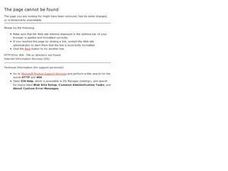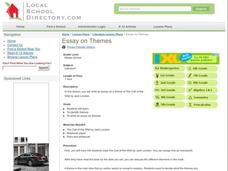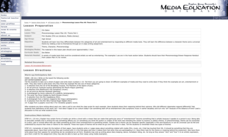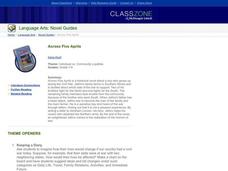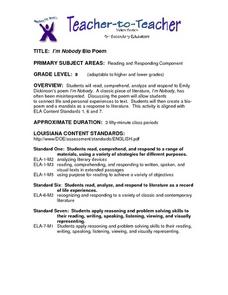Curated OER
Introduction to Little House Books
Third graders identify the main characters in the Ingalls family and describe the relationships between the characters. They locate the setting of the book on a map of the Upper Mid- West. Students understand that the books are set in...
Curated OER
Identifying Science Fiction
High schoolers discuss works of science fiction that they read, highlight aspects that made each a part of science fiction genre, identify formal literary elements, and discuss ways each can be developed through science fiction.
Curated OER
Where's Walden and Why Henry?
Sixth graders understand how Thoreau can serve as both inspiration and model for the investigation of home places. They explore ways to become better observers of natural and cultural history. Students find out how to connect with their...
Curated OER
Festive resources
Students research activities on a festive/seasonal theme. They work on speaking activities like Christmas wishes. They analyze a cross cultural comparison of two festive/seasonal themes. Students include topics like Christmas and pets,...
Curated OER
Chocolate Chaos
Second graders demonstrate the ability to examine the elements of a story (theme, plot, setting, mood) and characters, by discussing and writing about each. They have fun with chocolate related activities and enjoy reading about some...
Curated OER
Essay on Themes
Students read the book THE CALL OF THE WILD by Jack London and discuss the different elements in the book. They then write an essay on a theme providing examples backing up their main point of their essay.
Curated OER
Design a Book Cover
Learners use the programs Pics4Learning and ImageBlender 3 to apply their knowledge of characters, plot, setting, symbolism, and conflict to design and create a book cover. Designed as a culminating literature activity.
Curated OER
And the Moral of the Story is...
Students discover the parts of a story through the retelling of a fable as well as characters, plot, and setting. This lesson is completed using the program Pixie to create an online storybook.
Curated OER
Identifing Elements of Narrative Writing
Students explore the concepts of narrative writing. They identify the basic elements in narrative writing such as the setting description, characters, conflict, climax and resolution. Using five adjectives from a previous spelling unit,...
Curated OER
Breaking Up is Hard To Do
Students study the geographical issues related to the conflict in the Caucasus while identifying and discussing other key issues. They investigate methods of conflict resolution while analyzing both sides of the conflict including those...
Curated OER
Comparing Similar Themes in Art And Literature
Students view examples of Rembrandt's artistic works that include beggars and the unfortunate. They also read The Whipping Boy by Sid Fleischmann. They use a Venn diagram to compare and contrast the themes shared by each.
Curated OER
From the Source to the Sea: The Nisqually River Watershed
Students research the conflicts over different uses of the Nisqually River resources and role play as mediators between Chief Leschi and other interested parties. They cite and interpret relevant artifacts and primary and secondary...
Curated OER
Phenomenology Lesson Plan #6: Theme Part 1
Pupils practice differentiating between categories of art and entertainment. They also practice telling the difference between character themes and universal themes. They find a text to relate to themselves and write about it.
Curated OER
Story Maps and Boxes
Students use a story map template to review the parts of a story and information about a book that they have read. The elements of the story are identified and placed into story boxes and shared with classmates.
Curated OER
William Tell Overture
Young scholars explore the musical concepts of rhythm, melody, expression, and tone color in a three-lesson unit about the William Tell Overture. They identify dynamics and tempo and play a vocal tone color singing game.
Curated OER
Macbeth
Students discuss the changes the characters go through in Shakespeare's play Macbeth. They discuss the themes of the play write an essay comparing current events to the themes of the play.
Curated OER
Haydn's Surprise
Students listen to Haydn's "Surprise" and use the score to create themes and variations with other rhythms. They create poems using Haydn's rhythm in the symphony and research his life. They also use "body percussion" to play parts of...
Curated OER
A Peaceless Land: Conflict Continues in the Middle East
Young scholars examine the conflict in the Middle East. They discover the history of the region to better explain why there is conflict in the region. They also analyze the political negotiations that have occured over the years.
Curated OER
Reading the Movies: Another Approach To Teaching Critical Thinking Skills And Writing
Students explore the elements of film to analyze character, action, and the themes in the movie, "Quiz Show." The lesson encourages students to make personal connections and real life applications as they view the movie, critically.
Curated OER
We Can Work It Out
Students practice conflict resolution by considering alternatives before reacting to a conflict.
Curated OER
Across Five Aprils
Students read the novel, Across Five Aprils and investigate the theme of the individual vs, community loyalties. They keep a daily journal, role-play situations, hold a mock debate, and write a research paper on "coming of age."
Curated OER
I'm Nobody Bio Poem
Eighth graders analyze Emily Dickinson's poem, I'm Nobody. After discussing it, they create their own bio poem. They draw and label mandalas and display them in class.
Curated OER
Information Problem Solving--Lesson 3 of 5
Students examine a selected story/book and practice identifying the setting, characterization, and plot. As a class, they identify problems in the story, turning points and the climax. They use a rubric to evaluate the story, as well.
Curated OER
Story Creation Magic: Character, Setting, Plot
Students review the terms plot, setting, and characters and examine how all of these elements are needed to make a story. They are given parts of stories and they try to identify all of those parts of the story.




